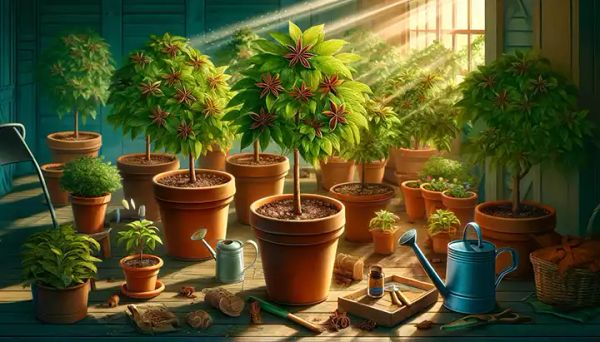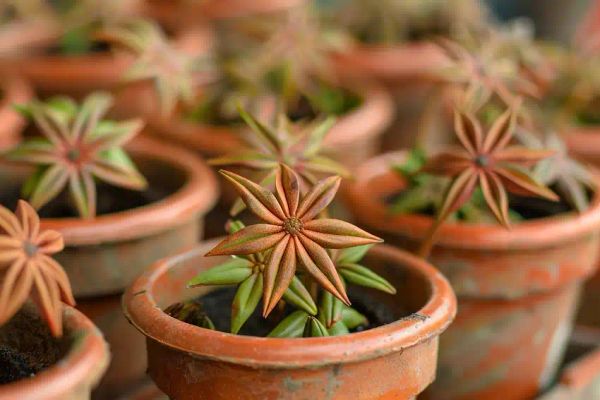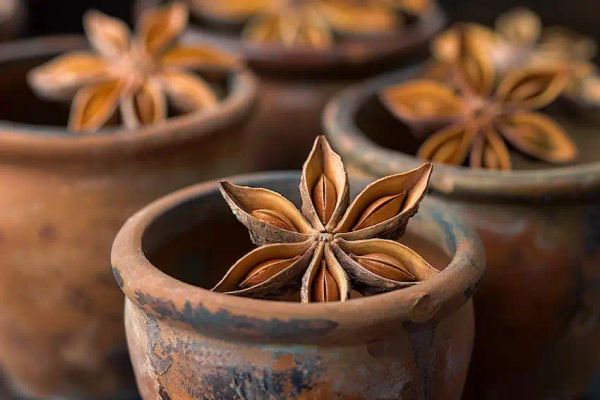Star anise is a unique spice that not only adds a delightful licorice flavor to dishes but also has medicinal properties. If you’re between 45 and 65 years old and have always wanted to grow this exotic spice in your own garden, this guide is for you! It will take you through the process of growing star anise in pots, from seed to harvest.

Understanding Star Anise
Star anise, also known as Illicium verum, is the real star anise that is used as a spice and in herbal medicine. It is important to note that this is different from the toxic Japanese star anise. Although star anise trees can grow quite large, they can adapt well to living in containers if properly taken care of.
Choosing the Right Container
When growing star anise in pots, it’s essential to choose the right container. Here are some tips:
- Size: Opt for a deep pot with a diameter of at least 18-24 inches. Star anise has a taproot system that requires space to grow.
- Material: Ceramic or terracotta pots are ideal as they provide breathability and help manage moisture levels.
- Drainage: Make sure your pot has excellent drainage to prevent waterlogging, as star anise roots do not tolerate excess water well.
Propagation and Planting
Growing star anise from seeds can be a bit challenging due to their hard outer shell. Here’s what you need to know:

- Seed Preparation: Soak the seeds in water for 24 hours to soften the tough outer shell.
- Soil Requirements: Use a well-draining and fertile potting mix with a pH level of 6.5-7.5. Adding aged compost can help enrich the soil.
- Planting: Sow the seeds about an inch deep into the soil, spacing them roughly 2-3 inches apart. Cover lightly with soil and water gently.
Optimal Growing Conditions
To ensure the success of your star anise plant, it’s important to provide the right growing conditions:
- Light: Star anise requires full sun, so place your pot in a spot where it will receive at least six to eight hours of sunlight daily.
- Temperature: This spice thrives in temperatures between 55°F and 75°F. If you live in a cooler climate, consider moving your pots indoors during winter.
- Humidity: Star anise loves humidity. If your environment is dry, use a humidity tray or mist the leaves regularly to provide the moisture it needs.
Care and Maintenance
Taking care of your star anise plant is relatively easy. Here are some important tips:

- Watering: Water the plant when the top inch of soil feels dry. Avoid overwatering, as star anise prefers slightly dry conditions between watering sessions.
- Fertilizing: Feed your plant with a balanced, slow-release fertilizer every two months during the growing season.
- Pruning: Regular pruning isn’t necessary unless you want to control its size or remove dead or diseased branches.
Pest and Disease Management
Star anise is generally resistant to diseases, but it’s important to watch out for common pests like aphids and spider mites. Use organic pesticides or introduce natural predators like ladybugs to your garden as a control measure.
Harvesting
Harvesting star anise requires patience, as it takes about six years for the trees to start producing fruit. Here are some guidelines:
- Time: The seeds are usually harvested in autumn, once the seed pods have matured but before they open.
- Method: When the seed pods are ready, harvest them and dry them in a place away from direct sunlight to preserve their essential oils.
Challenges and Tips
Growing star anise is a long-term commitment, especially when starting from seed. Here are some tips to keep in mind:
- Patience is key: Growing star anise takes time, so be patient and don’t get discouraged.
- Regular check-ups: Monitor your plant for signs of stress or disease and adjust its care as needed.
- Overwinter indoors: If temperatures drop below 55°F, it’s best to bring your star anise indoors to protect it from the cold.
Growing star anise in pots may be ambitious, but it’s a rewarding endeavor. With patience and proper care, you can enjoy the aesthetic and culinary benefits of this exotic spice. Whether you use it in cooking, as a decorative piece, or in medicinal teas, star anise will be a delightful addition to your home garden.





